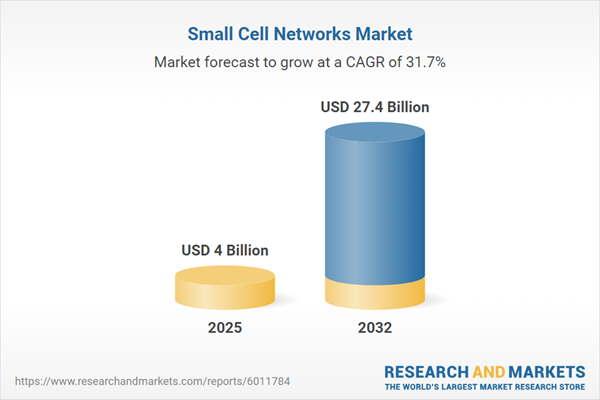Speak directly to the analyst to clarify any post sales queries you may have.
Small cell networks are reshaping wireless connectivity, providing advanced solutions for coverage, capacity, and scalability demands across various environments. This research report delivers actionable intelligence for leaders navigating the evolving landscape of network architectures driven by 5G and IoT requirements.
Market Snapshot: Small Cell Networks Market Size & Growth
The Small Cell Networks Market grew from USD 3.02 billion in 2024 to USD 4.00 billion in 2025. It is expected to continue growing at a CAGR of 31.70%, reaching USD 27.40 billion by 2032. This expansive growth trajectory is closely tied to rising mobile data volumes, increased device density in urban and rural areas, and the deployment of next-generation wireless technologies. The market’s upward momentum is further encouraged by the transition towards software-defined solutions and the adoption of advanced spectrum bands for optimized performance.
Scope & Segmentation
- Type: Femtocell (Enterprise, Residential), Microcell (Indoor, Outdoor), Picocell (Enterprise, Outdoor)
- Deployment: Indoor (In-building, Street Furniture such as lamp posts and traffic lights), Outdoor (Rural, Urban)
- Application: Enterprise (Campus, Office), Public Safety, Residential (Multi-Dwelling Unit, Single-Family), Retail (Shopping Mall, Storefront), Transportation (Rail, Roadways)
- Technology: 4G (LTE, LTE-Advanced), 5G (5G-Advanced, NR)
- Frequency Band: mmWave (28 GHz, 39 GHz), Sub-6 GHz (2600 MHz, 3500 MHz)
- End User: Enterprises, Public Sector, Telecom Operators
- Backhaul: Wired (Copper, Fiber), Wireless (Microwave, Millimeter Wave)
- Regions: Americas (United States, Canada, Mexico, Brazil, Argentina, Chile, Colombia, Peru), Europe, Middle East & Africa (United Kingdom, Germany, France, Russia, Italy, Spain, Netherlands, Sweden, Poland, Switzerland, United Arab Emirates, Saudi Arabia, Qatar, Turkey, Israel, South Africa, Nigeria, Egypt, Kenya), Asia-Pacific (China, India, Japan, Australia, South Korea, Indonesia, Thailand, Malaysia, Singapore, Taiwan)
- Key Companies: Telefonaktiebolaget LM Ericsson, Huawei Technologies Co., Ltd., Nokia Corporation, ZTE Corporation, CommScope Inc., Cisco Systems, Inc., Samsung Electronics Co., Ltd., Airspan Networks Inc., Fujitsu Limited, NEC Corporation
Key Takeaways: Strategic Insights for Senior Decision-Makers
- Small cell networks offer solutions to urban and rural connectivity gaps, enhancing user experiences by creating targeted coverage zones.
- Integration of edge computing and artificial intelligence enables adaptive network management, optimizing both resource allocation and energy consumption.
- Collaborations among OEMs, chipset manufacturers, and cloud platforms are vital for minimizing ecosystem fragmentation and accelerating deployment timelines.
- Investments in open, cloud-native network architectures help future-proof infrastructure, facilitating smoother service expansions and technology upgrades.
- Regulatory and infrastructure conditions significantly influence deployment strategies across different regions, requiring tailored approaches for optimal impact.
Tariff Impact on Small Cell Ecosystem
The 2025 United States tariff adjustments are poised to affect supply chains and component costs. Increased duties on critical radio frequency components drive equipment manufacturers to reconsider supply sources and realign production strategies. This may lead to prioritization of localized manufacturing, review of deployment roadmaps, and greater emphasis on vendor diversification to maintain favorable rollout schedules and manage costs.
Methodology & Data Sources
This study uses a multi-stage research approach that blends primary interviews with senior network architects, regulatory experts, and industry executives with secondary analysis of corporate reports, white papers, standards body publications, and patent databases. Data were cross-validated through triangulation to enhance accuracy and identify underlying trends.
Why This Report Matters
- Enables decision-makers to identify scalable deployment models and anticipate regulatory or operational obstacles in global markets.
- Provides a comprehensive view of technology adoption and strategic priorities to support organizational planning and risk mitigation.
- Uncovers actionable opportunities for collaboration and investment, supporting timely innovation and expansion initiatives.
Conclusion
The small cell networks landscape is evolving rapidly, underscored by converging technology shifts and dynamic regulatory changes. Organizations that leverage innovative deployment strategies and collaborative approaches can capture emerging opportunities and drive sustainable network growth.
Additional Product Information:
- Purchase of this report includes 1 year online access with quarterly updates.
- This report can be updated on request. Please contact our Customer Experience team using the Ask a Question widget on our website.
Table of Contents
3. Executive Summary
4. Market Overview
7. Cumulative Impact of Artificial Intelligence 2025
List of Figures
Samples

LOADING...
Companies Mentioned
The key companies profiled in this Small Cell Networks market report include:- Telefonaktiebolaget LM Ericsson
- Huawei Technologies Co., Ltd.
- Nokia Corporation
- ZTE Corporation
- CommScope Inc.
- Cisco Systems, Inc.
- Samsung Electronics Co., Ltd.
- Airspan Networks Inc.
- Fujitsu Limited
- NEC Corporation
Table Information
| Report Attribute | Details |
|---|---|
| No. of Pages | 196 |
| Published | October 2025 |
| Forecast Period | 2025 - 2032 |
| Estimated Market Value ( USD | $ 4 Billion |
| Forecasted Market Value ( USD | $ 27.4 Billion |
| Compound Annual Growth Rate | 31.7% |
| Regions Covered | Global |
| No. of Companies Mentioned | 11 |









